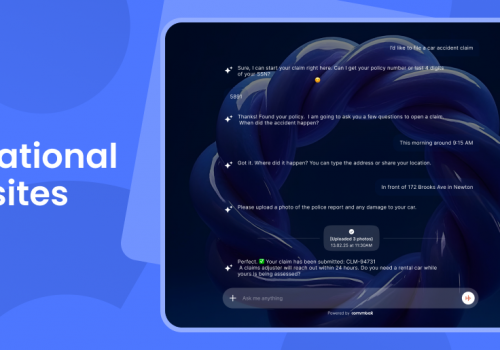Customer Success Team. We live in a world where 80% of customers would take their business to a competitor within a week of experiencing poor customer service. Customers now have more options than ever and that means if you want to make your business the best option, you have to focus your energy on customer loyalty, retention, and customer experience.
Of course, getting yourself on track to meet these goals is easier said than done and that’s why you need to create your success from the inside out. Your success starts with the teams within your business, and one team that has become essential to this endeavor is the Customer Success Team. Let’s take a look at what a Customer Success Team is, why you should have one, some tips and tricks for improving your customer experience, and how to get the most out of your customer success team.
What Is a Customer Success Manager (CSM)?
The role of “Customer Success Manager” was largely unheard of even a decade ago. However, as the business landscape has evolved in the digital age, it became clear that this role is needed to take businesses to the next level. Over the last decade, the role has been evolving, standardizing, and gaining traction has the world’s most successful businesses create their own Customer Success Teams.
Before the CSM role was established, the closest similar role was the role of Account Manager. Account Managers do great work in nurturing relationships and managing expectations with select clients, but they’re not focused on customer experience in the same way a CSM is. While the roles do have similarities, they also have distinct differences.
- Account managers focus on forming relationships with clients and managing their sales accounts. Account managers are the point of contact for many clients the account manager will try to keep the client happy so that more sales roll in. Although relationship management is a key part of the role, the ultimate goal is sales.
- Customer Success Managers manage long term relationships with clients with the ultimate goal being to increase customer satisfaction and customer success, and to keep retention rates high. While you could argue that the goal here is still to increase sales, the method the two roles go about this is distinctly different. CSM’s are interested in how customers use their products and aim to quickly address any concerns or to pass information onto relevant teams about how the product can be improved. Collecting and analyzing data about how customers use the product is a key part of the role and this data is invaluable in research and development of new products and improving existing products.

How a Customer Success Manager Contributes to Your Business
Customer Success Managers have several responsibilities that are aimed towards improving and maintaining relationships with customers. Below we’re going to break down some key responsibilities of the role and deconstruct how fulfilling these responsibilities will benefit your business. It’s important to note that while we’re discussing the role of CSM here, CSMs are often a part of a customer success team and responsibilities may be shared out to other team members.
Map Out Client Goals and Develop Strategies
CSMs are focused on improving and maintaining relationships with customers, or in more simple terms, they are tasked with improving customer loyalty. Customer loyalty and retention go hand in hand. To create loyal customers, you have to understand what your customer’s goals are. What do they hope to get from your product? Is it meeting their expectations at fulfilling this goal? Is there something that’s missing?
The most effective customer retention strategies involve addressing the concerns and emotions of consumers. According to research by Mosista shoppers with an emotional connection to the brand have a lifetime value four times greater than the average customer. The report also reveals that customers who are emotionally connected to the brand spend twice as much as customers who identify themselves as “satisfied”. You simply can’t address the concerns and emotions of your customers without talking to them about their goals, so this should be a priority for all customer success teams.
Training and Onboarding Clients on How to Use Your Products
While traditionally businesses have solely focused on sales pitches to clients, spelling out how a product will solve all of their problems, CSMs take a different approach. Your product may be excellent at solving a client’s problems, but they’re only going to get the most out of it if they understand how to use it.
In the past, companies were almost too afraid to tell clients how to use their products. After all, if you’ve got a well-made an intuitive product, then surely you shouldn’t have to explain how to use it, should you? Well, businesses are now starting to see the flaws in this approach. Acting blindly confident about your product and your customer’s ability to use it out of the box may secure you the first sale…but what about the second? The third? If customer retention is a top priority for your business (and it should be), then you need to start engaging with customers more openly and fully. A customer may not realize the extent to which your product could help them because they’ve only been using half the features. This may cause them to more to your competitors for their next purchase believing that you’re not the right fit for them, or worse, that they’ve been misled.
Suggesting Design Improvements
The customer success team has a real understanding of exactly how your products are being used and whether customers are satisfied with how they perform. CSMs can then pass this information on to the design and development teams so they can make improvements to the product on behalf of the customers.
Balancing Sales and Being a Client Advocate
In a business, each team has its own set of responsibilities and goals. This approach is great for maintaining focus, but often it can create problems when it comes to creating a unified approach to a problem. The overarching goal is to increase sales by increasing customer satisfaction, which is done by improving the customer experience. The sales team may be too focused on sales to understand what’s truly best for the customer, and this can affect future sales. The customer success team is somewhere in between. They understand the importance of sales and the crucial role the sales team plays within the business, but they also act as advocates for their clients and ensuring that their voices will be heard.
Collecting and Acting on Feedback
You need to make it easy for customers to give you feedback on your business and your products. This is a task that the Customer Success Team takes on. They will also continually tweak the feedback methodology to improve the quality of the data you receive. Sending out an email survey may not work for your customers, they might respond better to something else. Your Customer Success Team seeks to understand your customers better than anyone else and part of being a good CSM is understanding how to get quality data from customers. Once they have the data, they can act on it to improve the customer experience.

Customer Success Tactics to Improve Customer Service
Before we get started on a few tips and tricks here, it’s important to address the difference between customer satisfaction and customer success. Having satisfied customers is great, and certainly something that all businesses should be focused on. However, customer satisfaction shouldn’t be your only focus, customer success is also extremely important. So, what’s the difference? Customer satisfaction is when your customer is satisfied that your product meets their expectations. Customer success is when your product is achieving the customer’s goals.
The important thing to understand here is that you can have a satisfied customer even if they have never tried your product. For example, let’s pretend you have a language learning app. If a customer is using your app frequently then you can be confident that it’s achieving their goals because they’re getting value out of the app. However, you could send a survey out to customers to ask them what they think of the app and receive positive feedback from a customer who hasn’t used it. They might say “I love the app, the design is great and it looks fun, I just haven’t had a chance to use it yet.” This is customer satisfaction but not customer success.
Utilize Buyer Personas
A buyer persona is a fictional representation of your ideal customer based on real data about your existing customers. Creating a buyer persona is a great way for you to decide where to place your focus when it comes to product development and marketing. Your Customer Success Team will be invaluable in helping you create a buyer persona because they already have lots of hard data on your customers including demographics, behavior patterns, goals, and motivations. According to research by ITSMA, 82% of businesses have been able to improve their value proposition by utilizing buyer personas.
Target the Right Customers
Use your buyer persona to help you decide which customers to target. Sometimes casting a broad net can be a good thing, but it generally works best for homogenous products that have wide appeal. Milk is a good example of a homogenous product that has broad appeal. You can’t create an ideal customer to target your milk to. It’s essentially a staple product consumed by vast amounts of the population that may largely have nothing in common other than not being vegan or lactose intolerant. But if you do have an ideal customer, try and target them, or customers who share the majority of their traits. If you try to be too broad, then you risk not connecting with your ideal customer and your ideal customers are the most likely candidates of being your success stories.
Get Personal
Personalization is a huge marketing trend right now, and it’s with good reason. The world’s top businesses, even those with a customer base so large that they’d struggle to know their customers one on one, have managed to use personalization to great success. Customers love personalization. In fact, 80% of customers are more likely to purchase a product or service from a brand who provides a personalized experience. Your Customer Success Team will have key insights into what personalization approaches your customers feel the most engaged with.

7 Ways to Make the Most out of Your Customer Success Team
1. Equip Them with the Right Tools and Technology
Customer Success Teams need to be able to collect data on your customers in order to create strategies to improve customer success and build long-term relationships. This means they need software to help them collect and analyze data efficiently. AI and Machine Learning tools are booming right now and proving to be a popular choice for businesses of all sizes. If your business is using outdated technology, it’s time to upgrade so your team can reach their full potential. Even an excellent team will perform even better with the right tools.
2. Create a Customer Onboarding Process
A key part of a Customer Success Team’s role is to teach customers how to use your products. You may think your products are intuitive and need no explanation, but you have to keep in mind that you familiarize yourself with your product every day. When it comes to onboarding your customers, don’t leave it up to chance. Instead, you should create a robust strategy that proactively teaches customers how to get the most out of your product.
3. Allow Them to Be the Voice of Your Customers
Make sure your Customer Success Team is involved in all important meetings about developing new strategies. If you don’t engage your Customer Success Team and get their unique insight, you might be missing something that could potentially generate your more sales or connect with your customers in a more meaningful way.
4. Recruit the Right People
This may sound obvious at first glance – You’re not going to intentionally hire the wrong people, are you? However, the Customer Success Manager role is relatively new and this means there aren’t going to be a lot of applicants with prior experience in the role. Instead, you want to look for qualities like excellent people skills, team players, organization skills, and enthusiasm.
5. Know How Big You Need the Team to Be
If you have multiple buyer personas because your business targets multiple distinct groups of customers, then you should ideally have a CSM for each group. Your customer segments will have their own goals and experiences when it comes to your product so they should be captured separately.
6. Segment Your Customers
Leading on from the last point, it’s essential to segment your customers if you want to target them effectively. There are several ways to create your segments. You may decide to segment based on age, location, loyalty, buying behavior, or something else entirely. If you use customer segmentation, then you’ll be better equipped when it comes to building and structuring your Customer Success Team.
7. Decide on a Compensation Strategy
More and more businesses are choosing to utilize Customer Success Teams and understand the significant value they can bring to the business. Although CSMs don’t strictly focus on sales, the work they do directly impacts your company’s profits. Because of this, many businesses are choosing to compensate CSMs with bonuses or give them a commission for upsells. How you want to compensate the team is ultimately up to you and your business, but performance-based compensation can help boost motivation within the team.
Conclusion
You’re ready to go! Customer Success Teams are set to become a common feature within the majority of medium and large businesses as we move towards the future. With customer experience now being a top priority for all successful businesses, it’s now more important than ever to get to grips with who your customers really are and what they want. The only way to do this is to talk to your customers directly. Engage with your customers and learn how they’re using your product. Tell your customers how they can get more out of your product. And lastly, turn your satisfied customers into successful customers.




















